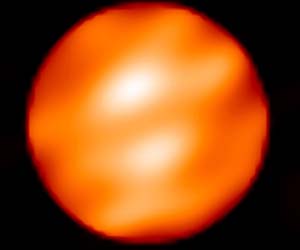Betelgeuse Star Facts

Infrared image of Betelgeuse, the two white areas are hotspots on the star's surface.
- Betelgeuse is 640 light years from Earth.
- It is classed as a red supergiant and is the tenth brightest star in the night sky.
- As part of the Orion constellation Betelgeuse can be easily found in the night sky through most of the year.
- High mass stars such as Betelgeuse burn their fuel extremely quickly, as a result they exist for only a few million years, stars such as our sun exist for billions of years.
- At only 10 million years old Betelgeuse is already near the end of its lifespan and is expected to explode as a supernova in the next million years.
- Supernovas occur when high mass stars can no longer fuse elements in their core.
- When Betelgeuse explodes it will appear as bright as the moon in the night sky for several weeks and may even be visible during the day.
- Supernovas produce deadly bursts of gamma ray radiation but fortunately Betelgeuse is too far away to cause any damage to Earth.
- Betelgeuse can acceptably be pronounced as 'Beetlejuice' although there are several variations in its pronouncement.

Betelgeuse which can be seen top left of center is part of the Orion constellation.
Betelgeuse Radius
Betelgeuse has around a thousand times the radius of the sun, if it was placed in the center of our solar system the star would reach beyond the orbit of Jupiter!
Betelgeuse Mass
Betelgeuse is estimated to have a maximum mass of around 20 to 30 times that of the sun.
Betelgeuse Temperature
Betelgeuse is estimated to have surface temperatures of around 3200C (5800F), around 60% as hot as the sun.
Betelgeuse Luminosity (energy emitted)
Due to its enormous size Betelgeuse is around 100,000 times more luminous than the sun.
Betelgeuse Statistics
Also Known As: Alpha OrionisDistance From Earth: 640 light years
Constellation: Orion
Star Type: Class M Supergiant
Mass: Estimates average around 20 times the mass of the sun
Luminosity: Approx 100,000 x Sun
Diameter: Approx 850 million miles (1.4 billion km) - 1000 x Sun
Temperature: Approx 3200C (5800F)
Age: Approx 10 million years old
Rotation Period: Estimated around 15 to 30 years